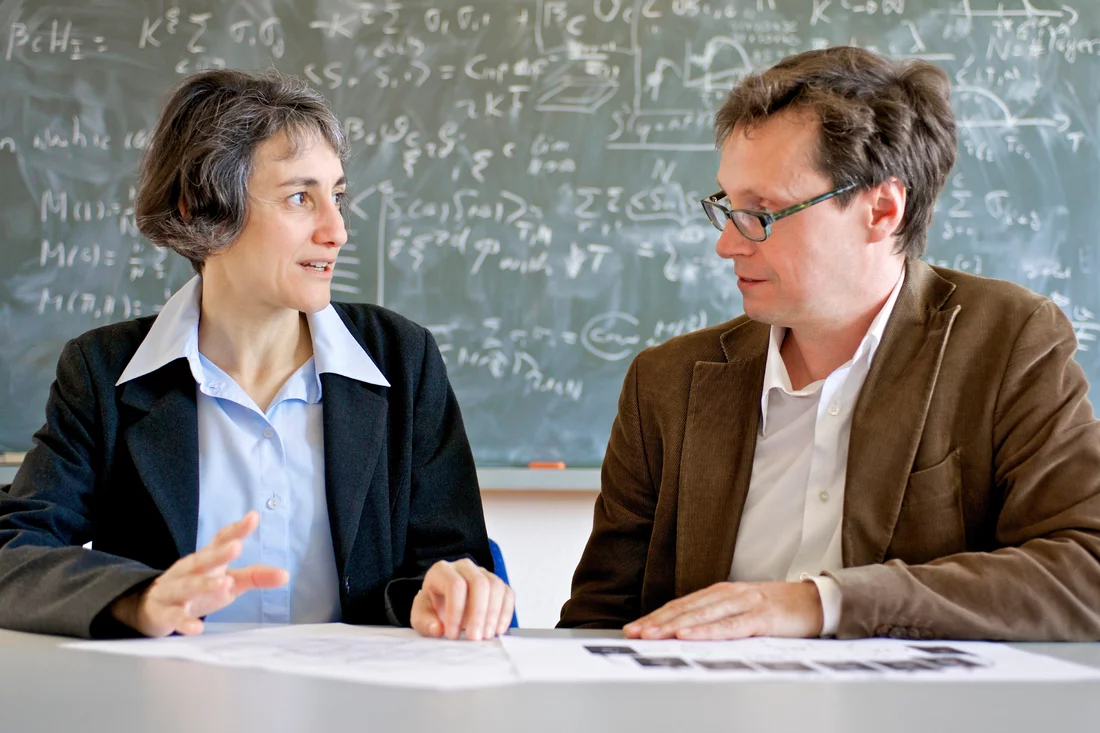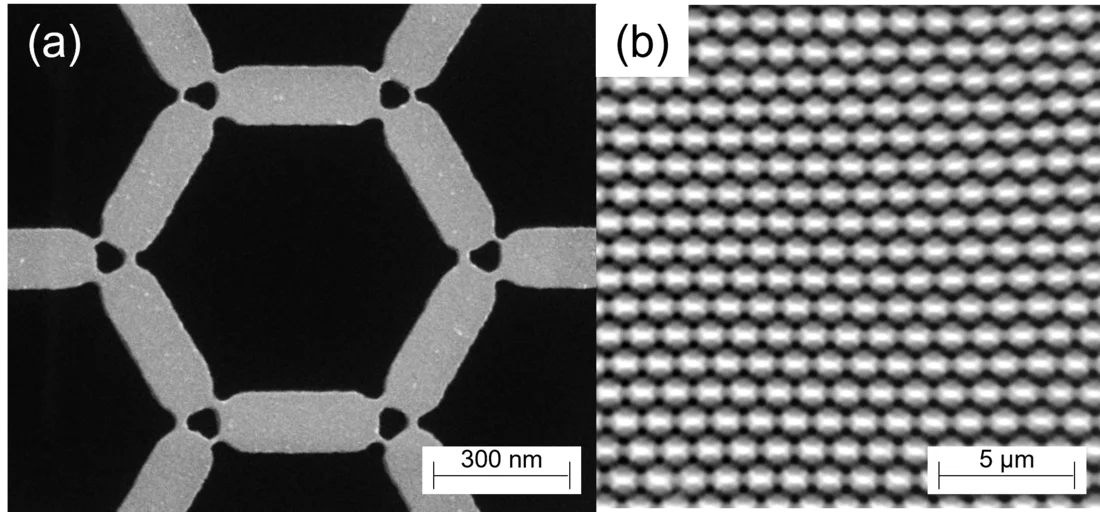Researchers at PSI have observed for the first time how tiny magnets in a special layout align themselves solely as a result of temperature changes. This view into processes that take place within so-called artificial spin ice could play an important role in the development of novel high-performance computers. The results were published today in the journal Nature Physics.
When water freezes to form ice, the water molecules, with their hydrogen and oxygen atoms, arrange themselves in a complex structure. Water and ice are different phases, and the transformation from water to ice is called a phase transition. In the laboratory, crystals can be produced in which the elementary magnetic moments, the so-called spins, form structures comparable to ice. That is why researchers also refer to these structures as spin ice. "We have produced artificial spin ice, which essentially consists of nanomagnets that are so small that their orientation can only change as a result of temperature," explains physicist Kevin Hofhuis, who has just completed his doctoral thesis at PSI and now works at Yale University in the USA.
In the material the researchers used, the nanomagnets are arranged in hexagonal structures – a pattern that is known from the Japanese art of basket weaving under the name kagome. "Magnetic phase transitions had been theoretically predicted for artificial kagome spin ice, but they have never been observed before," says Laura Heyderman, the head of the Laboratory for Multiscale Materials Experiments at PSI and a professor at ETH Zurich. "The detection of phase transitions has only been made possible now thanks to the use of state-of-the-art lithography to produce the material in the PSI clean room as well as a special microscopy method at the Swiss Light Source SLS." The journal Nature Physics is now publishing the results of these experiments.
The trick: tiny magnetic bridges
For their samples, the researchers used a nickel-iron compound called permalloy, which was coated as a thin film on a silicon substrate. They used a lithography process to repeatedly form a small, hexagonal pattern of nanomagnets, with each nanomagnet being approximately half a micrometre (millionths of a metre) long and one-sixth of a micrometre wide. But that's not all. "The trick was that we connected the nanomagnets with tiny magnetic bridges," says Hofhuis. "This led to small changes in the system that made it possible for us to tune the phase transition in such a way that we could observe it. However, these bridges had to be really small, because we didn't want to change the system too much."
The physicist is still amazed that this undertaking actually succeeded. With the creation of the nanobridges, he was pushing up against the limits of the technically possible spatial resolution of today's lithography methods. Some of the bridges are only ten nanometres (billionths of a metre) across. The orders of magnitude in this experiment are indeed impressive, says Hofhuis: "While the smallest structures on our sample are in the nanometre range, the instrument for imaging them – SLS – has a circumference of almost 300 metres." Heyderman adds: "The structures that we examine are 30 billion times smaller than the instruments with which we examine them."
Microscopy and theory
At the SIM beamline of SLS, the team used a special method called photoemission electron microscopy that made it possible to observe the magnetic state of each individual nanomagnet in the array. They were actively supported by Armin Kleibert, the scientist in charge of SIM. "We were able to record a video that shows how the nanomagnets interact with each other as we change the temperature," summarises Hofhuis. The original images simply contain black and white contrast that switched from time to time. From this, the researchers were able to deduce the configuration of the spins, that is, the alignment of the magnetic moments.
"If you watch a video like this, you don't know what phase you're in," explains Hofhuis. This called for theoretical consideration, which was contributed by Peter Derlet, PSI physicist and adjunct professor at ETH Zurich. His simulations showed what should theoretically happen at the phase transitions. Only the comparison of the recorded images with these simulations proved that the processes observed under the microscope actually are phase transitions.
Manipulating phase transitions
The new study is another achievement in the investigation of artificial spin ice that Laura Heyderman's group has been pursuing for more than a decade. "The great thing about these materials is that we can tailor them and see directly what is happening inside them," the physicist says. "We can observe all sorts of fascinating behaviour, including the phase transitions and ordering that depend on the layout of the nanomagnets. This is not possible with spin systems in conventional crystals." Although these investigations are still pure fundamental research at the moment, the researchers are already thinking about possible applications. "Now we know that we can see and manipulate different phases in these materials, new possibilities are opening up," says Hofhuis.
Controlling different magnetic phases could be interesting for novel types of data processing. Researchers at PSI and elsewhere are investigating how the complexity of artificial spin ice could be used for novel high-speed computers with low power consumption. "The process is based on the information processing in the brain and takes advantage of how the artificial spin ice reacts to a stimulus such as a magnetic field or an electric current," explains Heyderman.
About PSI
The Paul Scherrer Institute PSI develops, builds and operates large, complex research facilities and makes them available to the national and international research community. The institute's own key research priorities are in the fields of future technologies, energy and climate, health innovation and fundamentals of nature. PSI is committed to the training of future generations. Therefore about one quarter of our staff are post-docs, post-graduates or apprentices. Altogether PSI employs 2300 people, thus being the largest research institute in Switzerland. The annual budget amounts to approximately CHF 460 million. PSI is part of the ETH Domain, with the other members being the two Swiss Federal Institutes of Technology, ETH Zurich and EPFL Lausanne, as well as Eawag (Swiss Federal Institute of Aquatic Science and Technology), Empa (Swiss Federal Laboratories for Materials Science and Technology) and WSL (Swiss Federal Institute for Forest, Snow and Landscape Research). (Last updated in June 2024)
Contact
Original publication
-
Hofhuis K, Skjærvø SH, Parchenko S, Arava H, Luo Z, Kleibert A, et al.
Real-space imaging of phase transitions in bridged artificial kagome spin ice
Nature Physics. 2022; 18: 699-705. https://doi.org/10.1038/s41567-022-01564-5
DORA PSI



